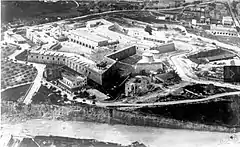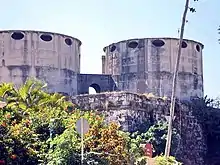Castillo del Príncipe (Havana)
The Castillo del Príncipe (Castle of the Prince) is a military fort located in the Loma de Aróstegui, in Havana, Cuba.
| El Castillo del Principe | |
|---|---|
 | |

| |
| General information | |
| Coordinates | 23.1307°N 82.3861°E |
History

The fort was built during the surge of military construction in Cuba, after the end of the Capture of Havana by the British that lasted almost a year, when the Spanish government realized that the city was unprotected and transformed the Key of the New World in the most fortified city in the Americas. The castle is named after Charles of Bourbon, Prince of Asturias, son and future successor of King Charles III of Spain. The construction was led by Colonel of engineers Don Silvestre Abarca who also built the Fortress of San Carlos de La Cabaña overlooking Havana bay.
Work begin in 1767; by 1771 the location was fortified; work continued until 1779.
The fortress housed detainees and prisoners, including the teacher of José Martí, Rafael María de Mendive, Julio Antonio Mella, Eduardo Chibás, Raúl Roa García, Juan Marinello and many other prominent revolutionaries.
Structure
The castle has the shape of an irregular pentagon and has two bastions, two semi-bastions and a redan (V-shaped protrusion), further comprises deep trenches, mine galleries, warehouses, offices, a water cistern and a housing area large enough to accommodate a garrison of 1000 soldiers. Its defensive artillery had 60 cannons of various calibers. It also has a system of tunnels built with red bricks that allow communication with all the outposts and most remote positions of the castle.
The position of Castillo del Príncipe allowed a broad view of the city, to the remains of the old city wall, from Campus Martius.
The fort overlooked Avenue Carlos III (today officially called Avenue Salvador Allende), which led to the house of rest and recreation of the Captains General, called Quinta de los Molinos.
Prison

The fortification had various uses including as a prison that served from colonial times until the triumph of the Cuban Revolution. After the arrival of the revolutionary forces the fort became the home of a unit of military ceremonies. The fort was primarily used by Castro's revolutionary armed forces to hold common and political prisoners. During 1961-1962 it housed surviving members of the Bay of Pigs Invasion who were ransomed on Christmas Day 1962.
<The Bay of Pigs: The Leaders' Story of Brigade 2506 (9780393331202): Johnson, Haynes: Books.>
References